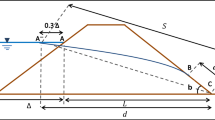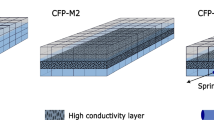Abstract
Seepage analysis plays a key role in geotechnical engineering and contributes significantly to the success of its infrastructure projects. Several engineers consider the Finite element (FE) method basics when executing calculations for designing hydraulic structures and dams. Numerical methods are used herein to solve the problem of seepage flow of water under concrete dams. The FE method is applied to model the dam structure and water level. The seepage velocity distribution in the porous soil is determined, and the effects of varying multiple parameters on the velocity are studied. The different parameters investigated are the dam dimensions (i.e., width (4,8,10,15 m) and depth (0,2,4,8 m)), upstream water head level (10, 15, 20 m), soil permeability (10, 15, 20 m day−1) and ambient temperature (5 °C and 50 °C). The developed FE models were validated by carrying out comparisons with analytical solutions that showed that they were in good agreement. It was found that the dam width is inversely proportional to the seepage rate and is independent of the water head level where increasing the dam by 1 unit width drops the seepage by 3.7% regardless of the water head levels. The depth of the dam is exponentially related to the distance away from the toe and independent of both the dam’s width and water head level. Increasing the dam depth reduces the seepage flow by 73% at shallower depths and the effect minimizes as we increase the depth to 1% reduction in seepage simulating an exponential behavior. Such behavior is typical for the dam depth factor regardless of the dam width and water head level variations used in the study. The water head level was also found to be linearly proportional to the seepage flow rate with an increased effect of about 10% per additional 1-m head level. In addition, the soil permeability is linearly proportional to the seepage rate, and the same increment is obtained regardless of the dam’s dimensions and water head level. The effects of ambient temperature on the seepage flow were introduced in this paper and will be further studied in detail in our future simulations. Our study concludes that the developed FE model can predict the seepage flow of water under concrete dams with a reasonable level of accuracy.























Similar content being viewed by others
References
Anjam YN (2020) Singularities and regularity of stationary Stokes and Navier-Stokes equations on polygonal domains and their treatments. AIMS Mathematics 5(1):440–466
ANSYS, "A Finite element computer software and user manual for nonlinear structural analysis," ANSYS 2007, Vols. Inc. Canonsburg, PA, 2007.
Attia M, Razek MA, Salam AA (2021) Seepage Through Earth Dams with Internal Cut Off. Geotech Geol Eng 39(8):5767–5774
Chahar BR (2006) Analytical solution to seepage problem from a soil channel with a curvilinear bottom. Water Res Res. https://doi.org/10.1029/2005WR004140
Chen Y, Hu R, Zhou C, Li D, Rong G, Jiang Q (2010) A new classification of seepage control mechanisms in geotechnical engineering. J Rock Mech Geotech Eng 2(3):209–222
Chen S-K, He Q-D, Cao J-G (2018) Seepage simulation of high concrete-faced rockfill dams based on generalized equivalent continuum model. Water Sci Eng 11(3):250–257
Dai Q, Lei Y, Zhang B, Feng D, Wang X, Yin X (2019) A practical adaptive moving-mesh algorithm for solving unconfined seepage problem with Galerkin finite element method. Sci Rep 9:6988
Elliotis MC (2019) A mathematical model for a steady-state seepage flow of groundwater under a reinforced concrete dam. Appl Comput Geosci 1:100003
Fahim HM (1981) Dams. Pergamon, People and Development
Gao Y-T, Wang H, Qin Q-H (2015) Orthotropic Seepage Analysis using. J Adv Mech Eng 2(1):1–13
Haghighi AT, Tuomela A, Hekmatzadeh AA (2020) Assessing the Efficiency of Seepage Control Measures in Earthfill Dams. Geotech Geol Eng 38(5):5667–5680
Harr ME (1962) Groundwater and Seepage. Dover Publications Inc, New York
Jia J, Lino M, Jin F, Zheng C (2016) The Cemented Material Dam: A New, Environmentally Friendly Type. Engineering 2(4):490–497
JiHuan H (1998) Approximate analytical solution for seepage flow with fractional derivatives in porous media. Comput Methods Appl Mech Eng 167:57–68
Johari A, Heydari A (2018) Reliability analysis of seepage using an applicable procedure based on stochastic scaled boundary finite element method. Eng Anal Boundary Elem 94:44–59
Kacimov A, Obnosov Y (2012) Analytical solutions for seepage near material boundaries in dam cores: The Davison-Kalinin problems revisited. Appl Math Model 36(3):1286–1301
Larese A, Rossi R, Oñate E (2015) Finite Element Modeling of Free Surface Flow in Variable Porosity Media. Arch Comput Methods Eng 22:637–653
McCartney M (2009) Living with dams: managing the environmental impacts. Water Policy 11(S1):121–139
"National Geographic," [Online]. Available: https://www.nationalgeographic.org/encyclopedia/dams/#:~:text=A%20dam%20is%20a%20structure,create%20artificial%20lakes%20called%20reservoirs.. [Accessed 20 November 2020].
Neumann S, Witherspoon P (1970) Finite element method of analyzing steady seepage with a free surface. Water Resour Res 6(3):889–897
Peng B, Li J (2015) A three-field coupled model for seepage failure. Procedia Eng 126:377–381
Pham HT, Oo HZ, Jing C (2013) Stability of slope and seepage analysis in earth dam using numerical finite element model. Study Civil Eng Arch (SCEA) 2(4):104–108
Rubertis K (2018) Monitoring Dam Performance: Instrumentation and Measurements, Virginia: American Society of Civil Engineers, 2018.
Salmasi F, Norouzi R, Abraham J, Nourani B, Samadi S (2020) Effect of Inclined Clay Core on Embankment Dam Seepage and Stability Through LEM and FEM. Geotech Geol Eng 38(6):6571–6586
Singh AK, Mishra GC (2013) Foundation Stability of a Levee. Geotech Geol Eng 31(5):1555–1567
Tan X, Wang X, Khoshnevisan S, Hou X, Zha F (2017) Seepage analysis of earth dams considering spatial variability of hydraulic parameters. Eng Geol 228:260–269
Vandenboer K, van Beek V, Bezuijen A (2014) 3D finite element method (FEM) simulation of groundwater flow during backward erosion piping. Front Struct Civ Eng 8(2):160–166
Woodson RD (2009) “Chapter 2 - Evaluating concrete in concrete structures,” in Concrete Structures. Butterworth-Heinemann, Oxford, pp 3–18
Yared W, Kvamsdal T, Kvarving A, Nordal S (2015) Adaptive isogeometric finite element analysis of steady-state groundwater flow. Int J Numer Anal Methods Geomech 40(5):738–765
Ye Z, Jiang Q, Zhou C, Liu Y (2017) Numerical Analysis of Unsaturated Seepage Flow in Two-Dimensional Fracture Networks. Int J Geomech 17(5):04016118
Yosibash Z (2012) "Singularities in Elliptic Boundary Value Problems and Elasticity and Their Connection with Failure Initiation," in Interdisciplinary Applied Mathematics, Springer Nature , pp. 1–459.
Acknowledgements
The authors would like to acknowledge student funding from the Material Science and Engineering Ph.D. program at AUS.
Funding
No funding was received to assist with the preparation of this manuscript.
Author information
Authors and Affiliations
Corresponding author
Ethics declarations
Conflicts of interest
The authors declare that they have no conflicts of interest relevant to the content of this article.
Additional information
Publisher's Note
Springer Nature remains neutral with regard to jurisdictional claims in published maps and institutional affiliations.
Rights and permissions
About this article
Cite this article
Abokwiek, R., Al Sharabati, M., Hawileh, R. et al. A Finite Element Model for the Analysis of Seepage Flow of Water Under Concrete Dams. Geotech Geol Eng 40, 2823–2841 (2022). https://doi.org/10.1007/s10706-022-02065-1
Received:
Accepted:
Published:
Issue Date:
DOI: https://doi.org/10.1007/s10706-022-02065-1




